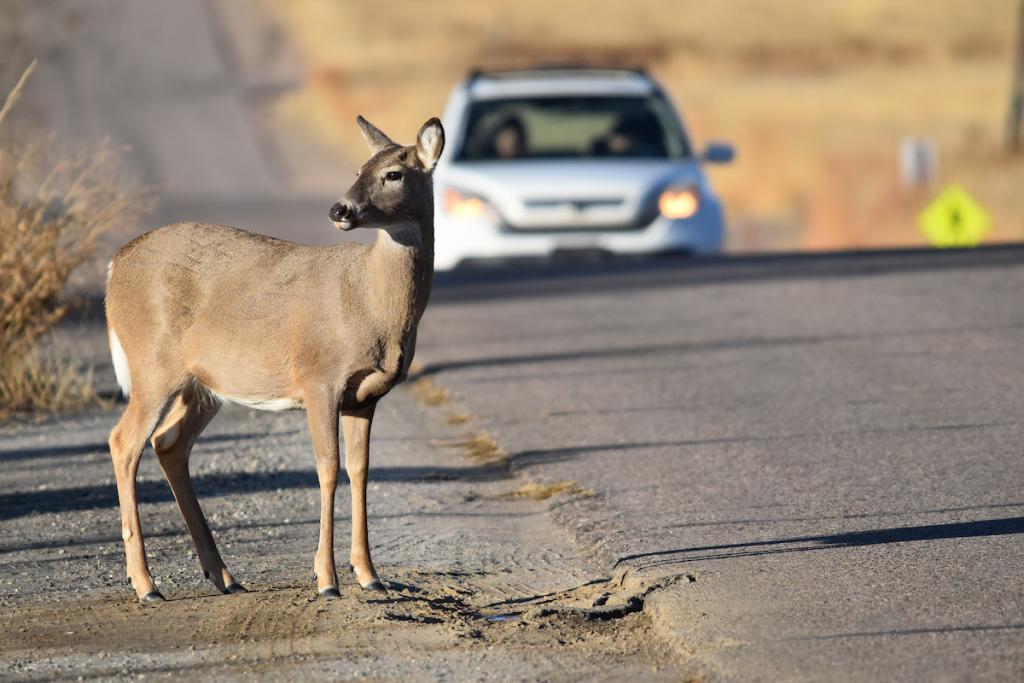CPW and CDOT Warn Drivers: Watch for Wildlife on Colorado Roads During Daylight Saving Time Change

Description: Colorado Parks and Wildlife, CDOT, and State Patrol urge drivers to watch for wildlife as daylight saving time ends Nov. 2. Slow down and stay alert for animals on the move.
Watch for wildlife on roads during daylight saving time
DENVER – Changing clocks and driving habits during daylight saving time can help prevent wildlife-vehicle collisions. Wildlife and transportation experts advise Colorado drivers that wildlife is on the move, drive with caution and slow down at night.
This Sunday, Nov. 2, 2025, marks the end of daylight saving time, which means people will set clocks back an hour, see dusk earlier and wildlife are migrating to wintering habitats during rush-hour traffic on roadways.
Colorado Parks and Wildlife (CPW), the Colorado Department of Transportation (CDOT) and Colorado State Patrol ask drivers to drive cautiously as colder weather pushes wildlife from the high country to lower elevations.
-
Slow down. Traveling at high speeds increases the danger of a crash. Moderate speeds maintain a driver’s reaction time and allow an appropriate response to animals on or near roads.
-
Stay alert. Pay close attention to the roadway between dusk and dawn, when deer and other wildlife are most active and crossing roadways.
-
Scan ahead. Watch for movement and shining eyes along roadsides. If you see one animal, you should expect others to be in the area.
-
Obey traffic signs. Many highways have wildlife warning signs intended to alert motorists of known wildlife movement areas. Transportation authorities attempt to reduce the number of wildlife-vehicle collisions by posting signage and lowering speeds in areas where wildlife is active.
-
Give warning. Slow down or stop when animals are seen on or near the road (if no other cars are behind you). Honk the horn and flash headlights to warn the animal to avoid the road and alert drivers to the potential hazard.
-
Avoid swerving. Never swerve or jerk the wheel of your car. Swerving can cause you to lose control, drive into another vehicle or drive off the road.
-
Always wear seat belts. Unfortunately, not every collision is avoidable. The risk of serious injury and death in a crash is reduced by half when seat belts are worn.
-
Report collisions. Drivers involved in a wildlife-vehicle collision should report the accident to the Colorado State Patrol by calling *CSP (star key and 277).
“Last year troopers responded to 3,777 crashes involving wildlife, with October, November and December as the most active months,” said Col. Matthew C. Packard, chief of the Colorado State Patrol. “Whether it is elk in the high country or pronghorn on the plains, there is no area of our state that doesn’t have wildlife. So, it is up to all of us to remove distractions and watch out for these beautiful animals.”
Animals like elk and deer have yearly migrations, following traditional paths between different seasonal areas, usually based on plant growth and weather. Wild animals need to be able to move between seasonal ranges to better respond to changes in habitat and landscape pressures.
Wildlife mitigation features are frequently added to planned highway improvement projects to help decrease the number of wildlife-vehicle collisions in Colorado. CPW and CDOT actively monitor wildlife data to identify potential highway mitigation projects that can protect wildlife on the move and keep motorists safe. Collaboration between the agencies has led to the development of statewide wildlife prioritization plans. To learn more, visit the Colorado Wildlife Transportation Alliance webpage.
"We are aware that roadways can be a huge obstacle for wildlife connectivity, and that is why CDOT’s design and engineering teams continue to explore ways to include wildlife mitigation features into our highway construction projects,” explained CDOT Chief Engineer Keith Stefanik. “We consider it a wise investment to include features like underpasses, overpasses and high wildlife fencing, especially when they can help reduce the number of wildlife-vehicle crashes by 80 to 90 percent.”
Colorado Highway Projects include:
Completed in 2024
-
CO 115 Penrose and Colorado Springs Wildlife Underpasses
Under Construction
"Colorado continues to be a leader in constructing wildlife crossings to reconnect habitats and reduce wildlife vehicle collisions. However, this time of year, wildlife are very active crossing roadways around the state as they move to their winter range,” said CPW Wildlife Movement Coordinator Michelle Cowardin. “It is important for motorists to scan the roadway and shoulders for movement, not be distracted, and obey speed limits to minimize their risk of an accident with wildlife."
Stay Informed about supporting wildlife movement.
-
Colorado Parks and Wildlife: cpw.state.co.us/wildlife-migration-and-movement
-
CDOT’s Wildlife Program:codot.gov/programs/environmental/wildlife
-
Colorado State Patrol: csp.colorado.gov
.png)


